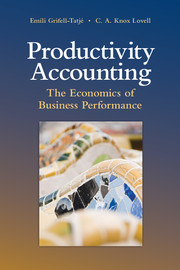Book contents
- Frontmatter
- Dedication
- Contents
- List of Tables
- List of Figures
- Preface
- 1 Introduction
- Part I Productivity and Profitability
- Part II Productivity and Profit
- Part III Productivity, Cost, and Return on Assets
- 7 Productivity and Cost
- 8 Productivity, Capacity Utilization, and Return on Assets
- Bibliography
- Author Index
- Subject Index
8 - Productivity, Capacity Utilization, and Return on Assets
Published online by Cambridge University Press: 05 January 2015
- Frontmatter
- Dedication
- Contents
- List of Tables
- List of Figures
- Preface
- 1 Introduction
- Part I Productivity and Profitability
- Part II Productivity and Profit
- Part III Productivity, Cost, and Return on Assets
- 7 Productivity and Cost
- 8 Productivity, Capacity Utilization, and Return on Assets
- Bibliography
- Author Index
- Subject Index
Summary
Introduction
We established the nature of the relationship between productivity and financial performance in Chapters 2 and 3, where financial performance was measured by profitability, in Chapters 4 to 6, where financial performance was measured by profit, and in Chapter 7, where financial performance was measured by cost. In this chapter we explore the relationship when financial performance is measured by return on assets (ROA), defined generically as π/A, the ratio of profit to assets.
The four measures of financial performance are closely linked. Profitability is a ratio, and profit is a difference. ROA combines the two, with a difference (π = R – C) in the numerator of a ratio. But the difference can be related to a ratio (Π = R/C), and so ROA is related to profitability as well as to profit. Thus, this chapter links the ratio analysis of Chapters 2 and 3 with the difference analysis of Chapters 4 to 6.
We began Chapter 7 with a discussion of various forms of cost cutting firms pursued in an effort to offset declining revenues during the global economic downturn that began in 2008.We revisit the issue, this time within an ROA context and a focus on financial institutions, which suffered during the downturn (or the global financial crisis). According to the US Federal Deposit Insurance Corporation (www2.fdic.gov/qbp), ROA at US commercial banks hovered in the neighborhood of 1% for over 15 years, and quickly turned negative at the onset of the downturn. ROA finally returned to its previous levels around 2010.
- Type
- Chapter
- Information
- Productivity AccountingThe Economics of Business Performance, pp. 310 - 358Publisher: Cambridge University PressPrint publication year: 2015



